Key takeaways:
- Chocolate cooking evokes emotions and nostalgia while allowing for culinary creativity.
- Understanding different chocolate types (bittersweet, semisweet, milk, white, dark) is essential for successful recipes.
- Key tools include a double boiler for melting, a kitchen scale for precise measurements, and a rubber spatula for efficient mixing.
- Techniques like microwave melting, double boiler, and sous vide enhance the chocolate melting process and result in superior texture.
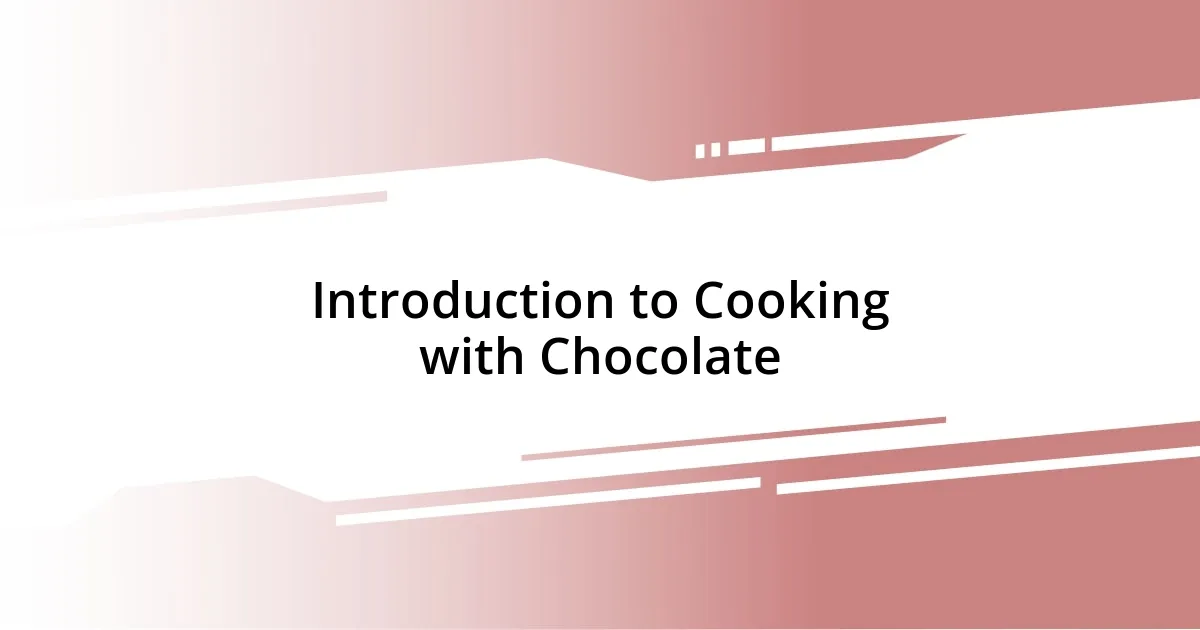
Introduction to Cooking with Chocolate
Cooking with chocolate is truly an adventure that stirs the soul. I remember the first time I melted chocolate for a cake; the rich aroma filled my kitchen, and I felt like alchemy was happening right before my eyes. Have you tasted that wave of excitement when your dish begins to transform with just a few simple ingredients?
When it comes to chocolate, it’s not just about flavor; it’s about the emotions it evokes. I often find myself reminiscing over childhood memories while crafting chocolate desserts—those moments of joy and togetherness that come alive with every bite. Isn’t it fascinating how a single ingredient can bridge the gap between nostalgia and creativity in the kitchen?
Understanding the different types of chocolate—like bittersweet, milk, and white—can drastically alter your culinary creations. Each variety has its unique flavor profile and melting point, which can make or break a dish. The thrill of experimenting with these elements keeps me engaged, as each attempt in the kitchen tells a different story of chocolate’s versatility. How can something so simple bring such complexity to our cooking?
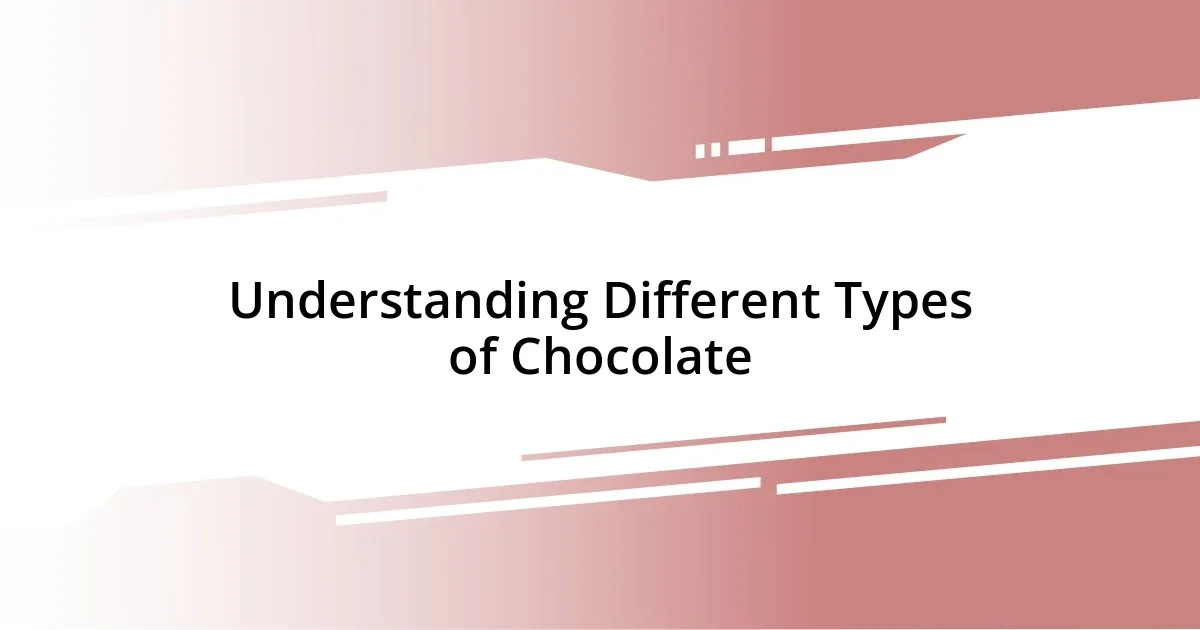
Understanding Different Types of Chocolate
When I first started exploring the world of chocolate, I was amazed by how diverse it truly is. Each type of chocolate offers its own unique flavors and characteristics that can elevate a dish or dessert in unexpected ways. For instance, I remember trying to make a classic chocolate mousse with semisweet chocolate—its deep, rich flavor combined with whipped cream created a luxurious texture that still makes my heart race just thinking about it.
Understanding the types of chocolate is essential for any cook, and here’s a quick breakdown of the most common varieties:
- Bittersweet Chocolate: Typically used in baking, it’s rich and has a higher cocoa content, making it perfect for deep flavors.
- Semisweet Chocolate: This is the chocolate I often reach for in cookies; it strikes a balance between sweetness and intensity.
- Milk Chocolate: Smooth and sweet, often enjoyed in candies and the first chocolate I ever enjoyed as a kid—nothing compares to that nostalgic sweetness.
- White Chocolate: Technically not chocolate as it lacks cocoa solids, but its creamy texture can add a lovely sweetness to desserts.
- Dark Chocolate: With a higher cocoa percentage, it offers a bold flavor that can be slightly bitter, which I love to mix into brownies for a sophisticated twist.
Exploring how these chocolates interact in various recipes is a delightful experience, and I find joy in experimenting to see which flavor combinations evoke the strongest memories or create the most excitement. Chocolate is more than just an ingredient; it’s a canvas for creativity and nostalgia.
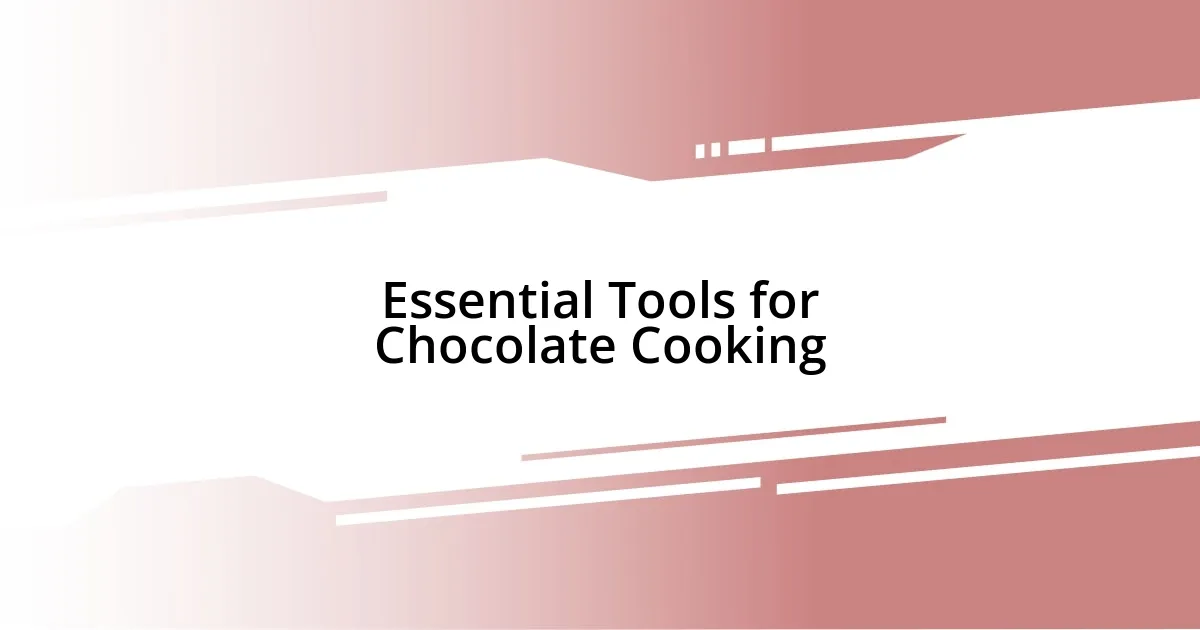
Essential Tools for Chocolate Cooking
When I think about cooking with chocolate, certain tools come to mind that have truly made a difference in my kitchen adventures. A good quality double boiler is one of my favorites. It gently melts chocolate without burning it, preserving its beautiful texture and flavor. I can still remember the first time I used one; the smooth melting chocolate seemed to dance in the steam, and I knew I was on my way to crafting something magical.
Aside from the double boiler, an accurate kitchen scale is crucial for ensuring precision in your measurements. I’ve found that weighing my chocolate leads to better results in my baking; it takes the guesswork out. For instance, when I once relied on measuring cups, I ended up with a chocolate cake that was too dense! Switching to a scale not only improved my baking, but also unleashed my creativity, allowing me to experiment with different recipes without fear.
Another tool that I’ve come to love is a high-quality rubber spatula. This tool is perfect for folding chocolate into batters or scraping out every last bit of melted chocolate from the bowl. I can’t express how satisfying it is to clean the bowl like a painter finishing a canvas. Each swirl and scrape makes me feel connected to the art of cooking, and I find joy in those small moments of kitchen magic.
| Tool | Purpose |
|---|---|
| Double Boiler | Gently melts chocolate without burning it |
| Kitchen Scale | Ensures accurate measurements for consistent results |
| Rubber Spatula | Folds and scrapes chocolate, ensuring nothing goes to waste |

Techniques for Melting Chocolate
Achieving that perfect melt with chocolate can be an art form in itself. One method I often use is the microwave—simple, right? Just make sure to chop the chocolate into small, even pieces to promote uniform melting. I learned this the hard way after once microwaving a large chunk, resulting in an uneven melt and a grainy texture. It’s always a good idea to start with short bursts of 20 seconds, stirring in between. With time, I’ve found that patience is key.
Another technique I swear by is the classic double boiler method. I still recall my excitement when I first witnessed how the gentle heat from simmering water transformed chocolate into a silky masterpiece. This method is particularly great for darker varieties that can be temperamental. Just remember, water and chocolate aren’t friends—getting any water in the chocolate could lead to seizing, and that disappointment is not something I’d wish on anyone! Have you ever faced that unfortunate mishap? It can feel disheartening, but it taught me to always keep my tools dry.
Lastly, I’ve dabbled with the sous vide technique for melting chocolate, and let me tell you, it adds a layer of precision that I find incredibly rewarding. It might seem extravagant at first, but the control you have over the temperature is remarkable, which is perfect for delicate types of chocolate. As a self-proclaimed chocolate lover, there’s something truly satisfying about melting chocolate at just the right temperature, resulting in a smooth texture that’s ready for any creation. Have you tried this method? It may sound fancy, but it really elevates your chocolate game!
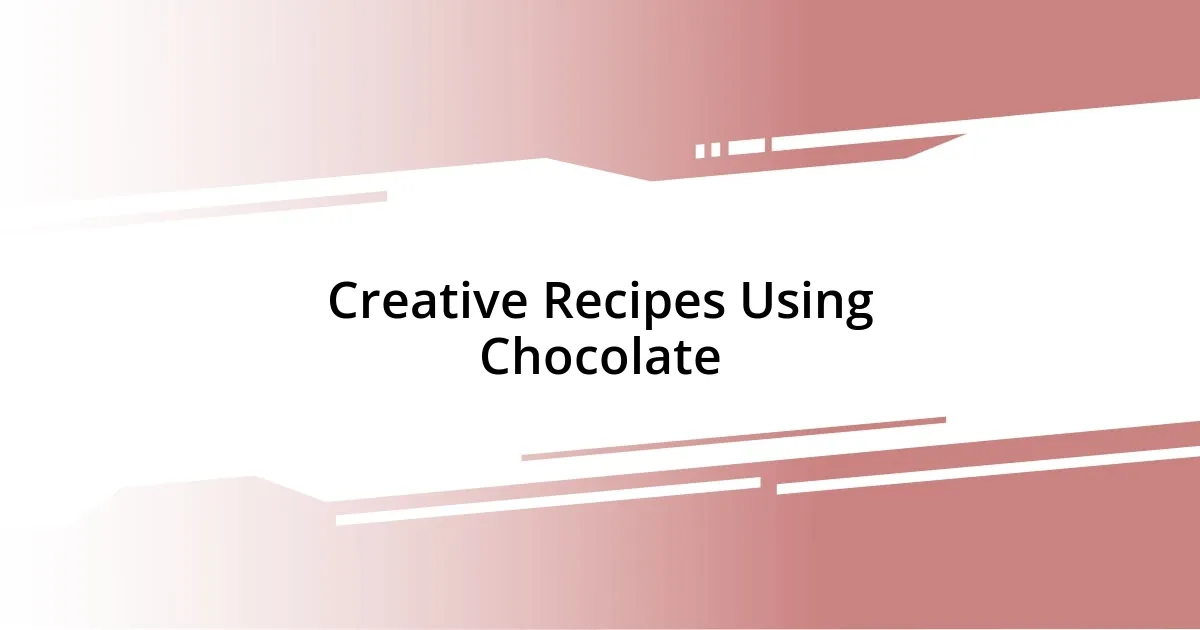
Creative Recipes Using Chocolate
There are so many creative ways to use chocolate that it sometimes feels like I’m just scratching the surface! One of my favorite recipes is chocolate bark, which is as simple as it is delightful. I remember the first time I made it; I tossed in some nuts, dried fruits, and even a sprinkle of sea salt for that sweet-salty combo. It’s like a canvas where I can express my flavor preferences, and I always get excited when friends ask for a taste.
Another recipe that has captured my heart is chocolate mousse. I’ll never forget the moment I first whipped that velvety mixture to perfection; the texture was so light, yet rich. It’s a perfect dessert for impressing guests—especially when topped with fresh berries! You can easily tweak the flavor by adding a hint of espresso or a splash of vanilla, and it’s mind-blowing how those small changes can elevate the whole dish. Isn’t it amazing how one ingredient can have such a transformative impact?
Finally, I’ve enjoyed exploring the world of chocolate sauces. Whether I’m drizzling it over pancakes or using it as a dip for fruit, it can turn an ordinary treat into something extraordinary in seconds. I vividly recall a brunch I hosted where the chocolate sauce stole the spotlight; everyone was dipping strawberries and bananas, and the laughter around the table reminded me why I love cooking with chocolate so much. Have you ever created a simple sauce and turned it into a highlight of your gathering? It’s those delightful, shared moments that truly bring the joy of cooking to life.
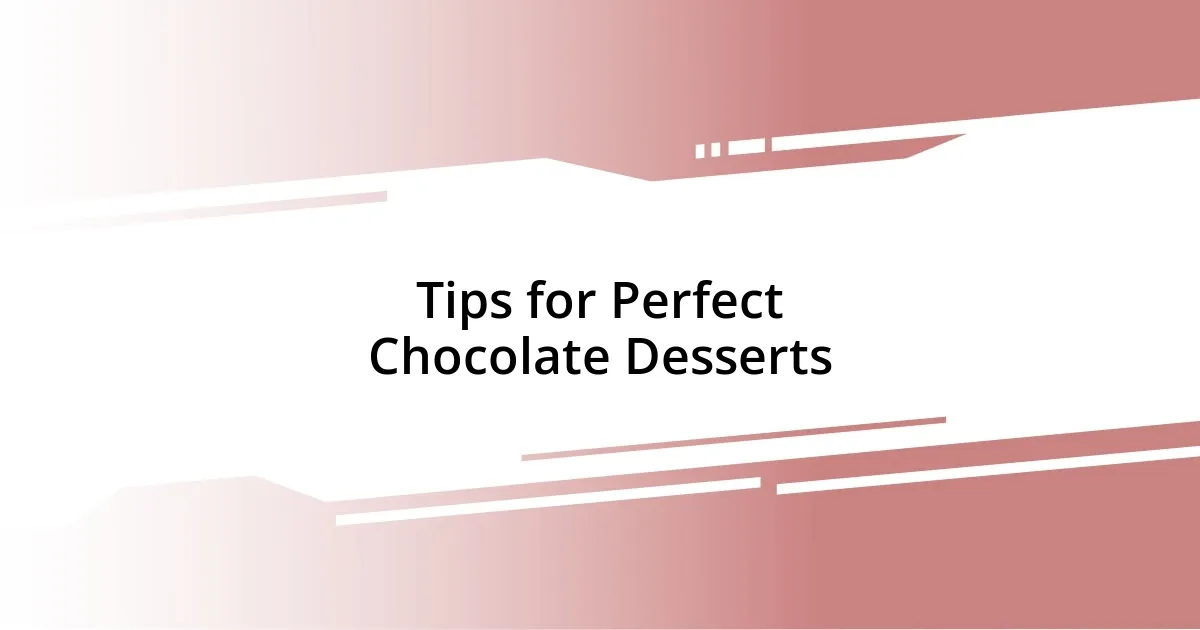
Tips for Perfect Chocolate Desserts
When it comes to creating perfect chocolate desserts, the quality of your chocolate speaks volumes. I remember the first time I used a high cocoa content chocolate for brownies; the difference was astonishing. The rich, intense flavor brought my dessert to life in a way that those standard chocolate bars just couldn’t match. Have you ever invested in good chocolate and noticed the uplift it provides? Trust me, it’s worth it.
Another tip I swear by is tempering chocolate when making confections. I once took the plunge into this method during a holiday get-together, turning ordinary truffles into treasures with that nice snap when you bite in. The process felt intimidating at first, with the constant stirring and monitoring temperatures, but the outcome was nothing short of stunning. There’s something magical about working with chocolate this way—you create a dessert that looks as incredible as it tastes.
Don’t forget about incorporating contrasting flavors and textures! A drizzle of sea salt over a rich chocolate tart can be a game changer. I’ve often paired chocolate with zesty citrus or smoky flavors, and the result is always delightful. One of my favorite moments was serving a chocolate orange cake; the guests couldn’t stop raving! What’s your go-to combo when you want to impress someone? Finding that perfect balance can elevate your creations to new heights, and it’s a joyful exploration each time.














